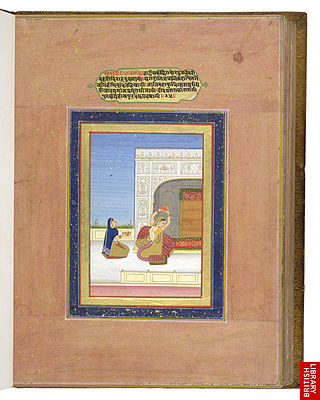| Hindustani classical music |
|---|
| Concepts |
| Genres |
| Thaats |

Purvi or poorvi is one of the ten basic thaats of Hindustani music from the Indian subcontinent. It is also the name of a raga within this thaat. [1]
| Hindustani classical music |
|---|
| Concepts |
| Genres |
| Thaats |

Purvi or poorvi is one of the ten basic thaats of Hindustani music from the Indian subcontinent. It is also the name of a raga within this thaat. [1]
Poorvi thaat adds a Komal Dhaivat to Marva thaat. These thaat ragas usually feature komal Rishabh, shuddha Gandhar and Shuddha Nishad along with teevra Madhyam, the note which distinguishes evening from the morning ragas (dawn and sunset). The thaat raga Poorvi is deeply serious, quiet and mysterious in character and is performed at the time of sunset. Pictorial depictions in early texts, often mention the poise, grace, and charm of Poorvi.
Ragas in Poorvi thaat include:
A thaat is a "parent scale" in North Indian or Hindustani music. It is the Hindustani equivalent of the term Melakartha raga of Carnatic music. The concept of the thaat is not exactly equivalent to the western musical scale because the primary function of a thaat is not as a tool for music composition, but rather as a basis for classification of ragas. There is not necessarily strict compliance between a raga and its parent thaat; a raga said to 'belong' to a certain thaat need not allow all the notes of the thaat, and might allow other notes. Thaats are generally accepted to be heptatonic by definition.

"Malhar" is a Hindustani classical raga. Malhar is associated with torrential rains.
Raga Malgunji is a Hindustani classical raga from the Khamaj Thaat. Some say it is a part of the Kafi Thaat too.
Darbari Kanada, or simply Raga Darbari, is a raga in Carnatic music. It is a janya ragam of 20th Melakarta raga Natabhairavi. Being an ancient raga, its original name is unknown. It is believed to be borrowed into Hindustani classical music by Miyan Tansen, the famous 16th-century composer in emperor Akbar's court. It belongs to the Kanada family. This tradition is reflected in the name itself; Darbar is the Persian derived word in Hindi meaning "court." As the most familiar raga in the Kanada family, it may sometimes also be called Shuddha Kanada or pure Kanada. It belongs to the Asavari thaat. This raag is called raaga Kaanada in Yakshagana Karnataka state dance. It is also sometimes written as Durbari and Durbarikanada.
Ahir Bhairav is a Hindustani classical raga. It is a mixture of Bhairav and the ancient, rare raga Ahiri or Abhiri, or perhaps a mixture of Bhairav and Kafi.
Alhaiya Bilaval is a Hindustani classical raga. It is the most commonly performed raga of a large group of ragas that are mainly based on a scale more or less identical to the Western major scale. For this reason, that scale itself is known as the Bilaval Thaat. It is often simply referred to as Bilaval, although in the 17th century Alhaiya and Bilaval may have been separate ragas. Alhaiya Bilaval is a raga in which M is the main key.

Asavari is a minor character from the Mahabharata, the love life of Karna but due to her father's arrogance, the marriage did not take place. She belongs to the Asavari thaat kingdom.
Bibhas is a Hindustani classical raga.
Sohini is a raga in Hindustani classical music in the Marwa thaat. Alternate transliterations include Sohani and Sohni. Like Bahar, it is a small raga, with not much space for elaboration. It emotes the feel of longing, of passive sensuousness.

Kafi is a raga in Hindustani classical music. It corresponds to Kharaharapriya in Carnatic music and Dorian mode in Western music

Jog is a Raga in Hindustani classical music. It is one of the more popular ragas appearing often in films. Sometimes, experts assign this raga to be a member of Kafi thaat.
Tilak Kamod is a Hindustani classical raga.
Jaijaivanti or Jaijaiwanti is a Hindustani classical raga belonging to Khamaj Thaat. According to the Guru Granth Sahib, this raga is a mixture of two others: Bilaval and Sorath. The raga appears in the latter section in Gurbani, as only four hymns were composed by Guru Tegh Bahadur, the ninth Sikh guru. These hymns were added by his son and successor Guru Gobind Singh in 1705 A.D. This raga is not mentioned in any Indian classical scriptures on music nor in the Ragmala.

Khamaj is one of the ten thaats of Hindustani music from the Indian subcontinent. It is also the name of a raga within this thaat.

Rishabha is the second svara out of the seven svaras of Hindustani music and Carnatic music. Rishabha is the long form of the syllable रे for simplicity while singing the syllable. Rishabha is pronounced as Re and Ri.

Gandhara is the 3rd svara from the seven svaras of Hindustani music and Carnatic music. Gandhara is the long form of the syllable ग. For simplicity in pronouncing while singing the syllable, Gandhara is pronounced as Ga.

Dhaivata is the sixth svara from the seven svaras of Hindustani music and Carnatic music. Dhaivata is the long form of the syllable ध. For simplicity in pronouncing while singing the syllable, Dhaivata is pronounced as Dha.

Nishada is the seventh and last svara in Hindustani music and Carnatic music. Nishada is the long form of the syllable नी. For simplicity in pronouncing while singing the syllable, Nishada is pronounced as Ni.

Madhyam is the fourth svara from the seven svaras of Hindustani music and Carnatic music. This article is written from the Hindustani perspective. Madhyam is the long form of the syllable म. For simplicity in pronouncing while singing the syllable, Madhyam is pronounced as Ma. It is also called as मध्यम in the Devanagri script.